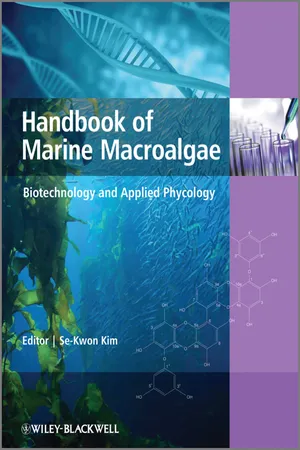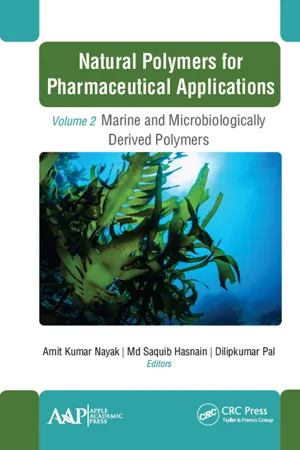Biological Sciences
Agar
Agar is a gelatinous substance derived from seaweed and is commonly used as a culture medium in microbiology to grow bacteria and other microorganisms. It provides a solid surface for microbial growth and is also used in food production as a thickening agent. Agar is heat stable, allowing it to be sterilized and poured into petri dishes for laboratory use.
Written by Perlego with AI-assistance
Related key terms
2 Key excerpts on "Agar"
- eBook - ePub
Handbook of Marine Macroalgae
Biotechnology and Applied Phycology
- Se-Kwon Kim(Author)
- 2011(Publication Date)
- Wiley(Publisher)
It is a hydrophilic colloid, composed of two polysaccharides, Agarose and Agaropectin. Agarose consists of alternating 1,4-linked 3,6 anhydro-α-L-galactopyranose and 1,3-linked β-D-galactopyranose. Agaropectin is more complicated in structure and contains sulfonic, pyruvic, and uronic acids. Agar contains 3–5% sulfate groups. Agar forms a strong gel, due to coil–helix transition followed by aggregation of helices, holding water molecules within the interstices, when a hot aqueous solution of Agar is cooled. Difference in gelling (32–40 °C) and melting (85 °C) temperatures of Agar, known as “hysteresis”, makes it useful in food, microbiological and pharmaceutical applications (Rodriguez et al., 2009; Prasad et al., 2007; Lahaye and Rochas, 1991). Food uses Agar is a popular thickener, gelling agent, stabilizer, lubricant, emulsifier, and absorbent. Unlike starch, Agar is not readily digested and therefore has little calorific value. Although Agar costs more than some synthetic and natural gelling agents, it is usually superior to such products because of its greater transparency, strength and stability over a range of acidities and alkalinities. Food grade Agar is used as a stabilizer in canned meat, confectionery, and glazing and as icing in the baking industry. It is also used to make jellies, puddings, and custards. Interaction of Agar with sugar increases the strength of the gel, by a phenomenon called “sugar reactivity”. Because of its bland taste, Agar does not interfere with the flavors of foodstuffs. The popular Japanese sweet dish, mitsumame consists of cubes of Agar gel containing fruit and added colors. It can be canned and sterilized without the cubes melting. In Indian cuisine, Agar is known as “China grass” and is used for making desserts. It has been used to clarify wines, especially plum wine, which is difficult to clarify by traditional methods - eBook - ePub
Natural Polymers for Pharmaceutical Applications
Volume 2: Marine- and Microbiologically Derived Polymers
- Amit Kumar Nayak, Md Saquib Hasnain, Dilipkumar Pal(Authors)
- 2019(Publication Date)
- Apple Academic Press(Publisher)
This composite hydrogel was able to load and subsequently release chemotherapeutics and antibiotics. Moreover, Agar-based nanocomposite film showed efficacy in inhibiting the growth of Listeria monocytogenes. Blends of Agar and different polysaccharides are also gaining importance in pharmaceutical aspects. This chapter gives an overview of the key features of inherent properties of Agar-Agar, their modification, with special attention to potential pharmaceutical applications. 3.1 INTRODUCTION In recent years, polymeric materials sourced from nature are on the spotlight in the fields of pharmaceutical research. Natural polymers are thought to have an edge on their synthetic counterparts because they are more copious, biocompatible, and biodegradable (Vendruscolo et al., 2009). Among natural polymers, Agar-Agar is a unique natural polymer that increasingly preferred over synthetic materials in addition to being considered alternative sources of raw materials for pharmaceutical applications. It has found its use as a digestive regulator, surgical aid, and in drug delivery. Agar-Agar is also used as a food ingredient; mainly as a gelling agent, for example, in making jellies, candies, and dessert items (Figure 3.1). Agar-Agar is recognized to be a safe product by the United States Food and Drug Administration Ordinance (USFDA) and also meet the requirements of the food chemicals codex (FCC). FIGURE 3.1 (See color insert.) Potential applications of Agar-Agar. Agar-Agar is a jelly-like substance, processed from certain red algae of the Rhodophyta phylum. It is a mixture of polysaccharides, which include galactose, 3,6-anhydrogalactose and inorganic sulfate bonded to the carbohydrate. Agar-Agar is composed of two components. It has the Agarose; a linear polysaccharide, and blend of smaller molecules, which are called Agaropectin (Figure 3.2) (Williams and Glyn, 2000)
Learn about this page
Index pages curate the most relevant extracts from our library of academic textbooks. They’ve been created using an in-house natural language model (NLM), each adding context and meaning to key research topics.

